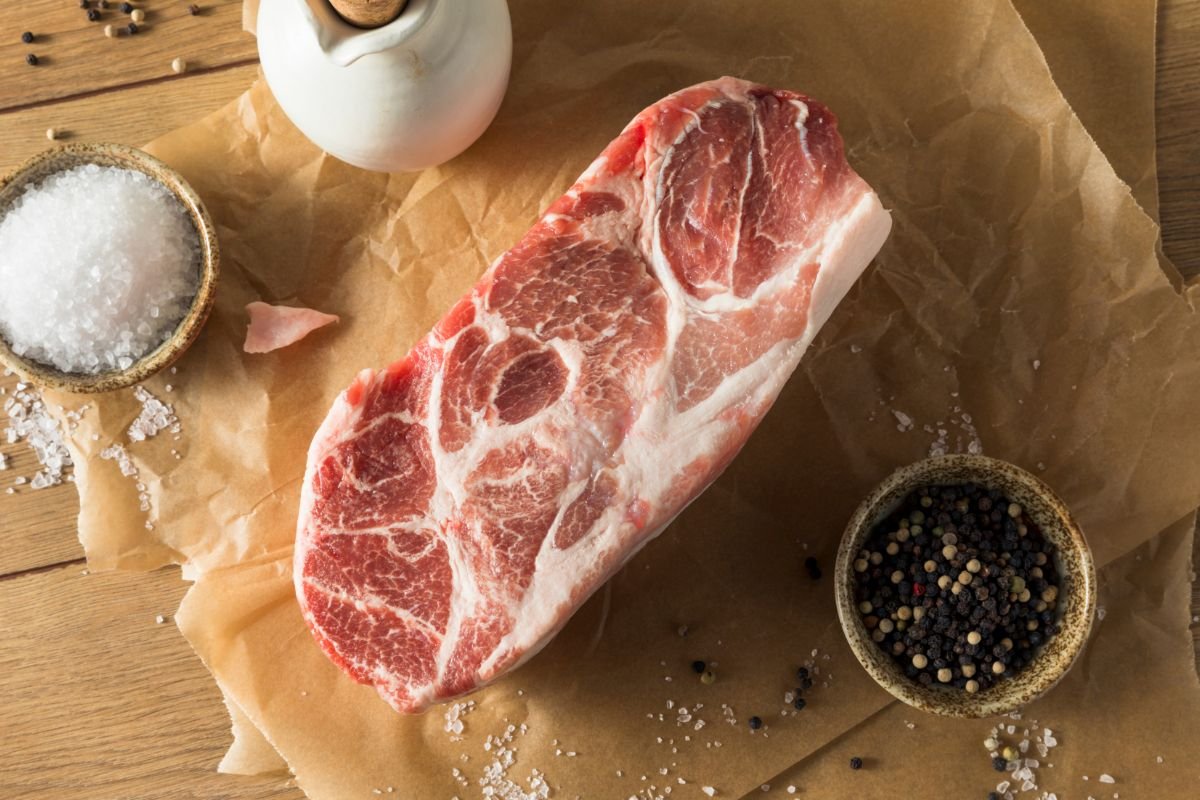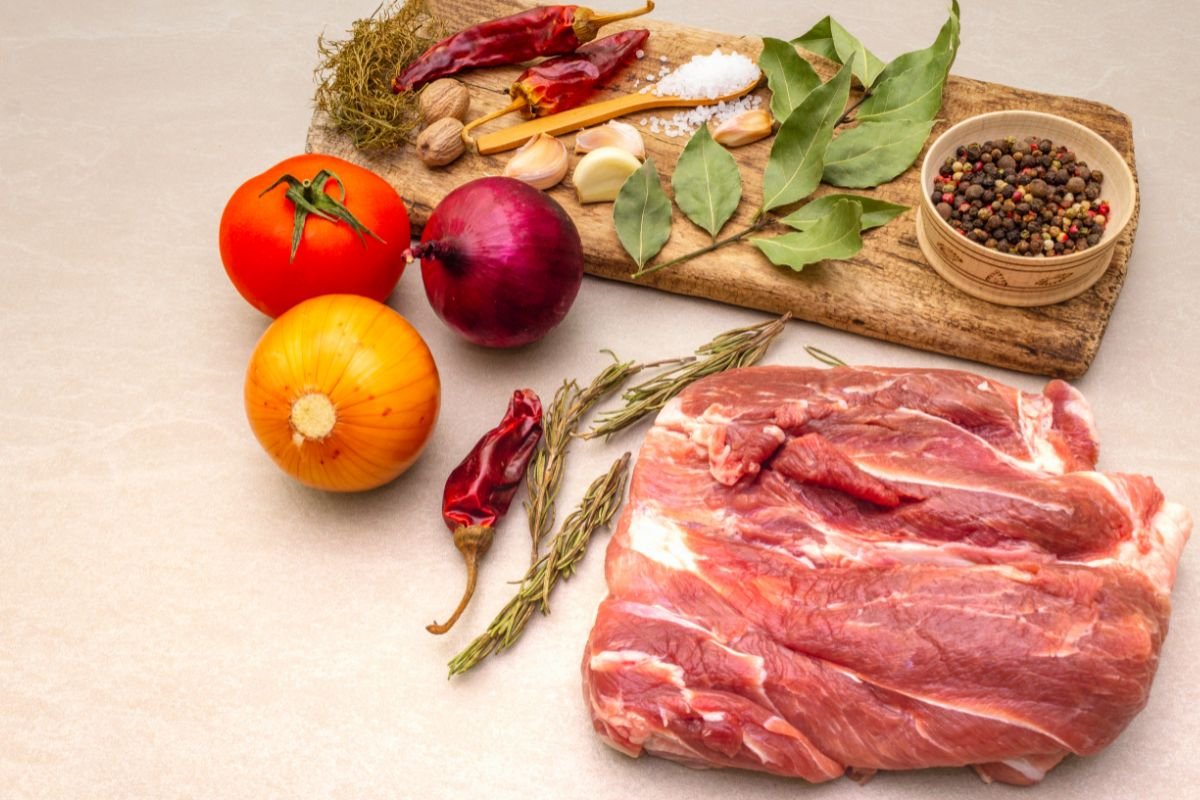Smoking pork shoulder can feel overwhelming even before you introduce the prospect of brining when you’re a beginner.

If you’re umming and arring on whether you should brine pork shoulder, you’ve come to the right place.
In this article, we will cover whether it’s necessary to brine pork shoulder.
So, next time you have a pork shoulder, you’re confident on what to do. Let’s get into it.
Notes On Pork Shoulder
A whole pork shoulder is made up of two cuts: the shoulder, and the pork butt, commonly referred to as the Boston butt.
While you can get hold of the whole pork shoulder, this cut can weigh a whopping 14-18 pounds, it tends to be reserved for commercial use.
The picnic shoulder is found beneath the pork butt, near to the upper part of the foreleg.
Similarly to pork butt, it’s made up of tough meat that needs to be cooked low and slow in order to tenderize it.
Failure to cook this right will result in tough, chewy meat that will leave your guests wishing – and this won’t be for your pork recipe.
To get the best results and make the most out of your joint of pork, then, you will need to cook it at a low temperature for a long period of time.
While you might be scared to cook low and slow in fear of overcooking your meat, the process of brining will help to keep the meat moist, even when it’s in the smoker for longer durations.
About Brining
As we just touched on briefly, the process of brining is all about helping your joint of meat to retain its moisture.
The salt content in the brine denatures the meat’s proteins, in turn allowing the cells to retain more moisture throughout the cooking process.
This allows you to cook your joint of meat for longer periods of time, without the fear of it drying out or becoming tough thanks to the added moisture.
Making a good brine is about more than the texture of your meat.
It can also give your meat a nice hint of flavor, so the ingredients you use are important!
If you’re just starting out, you might not know what your favorite brine ingredients are.
This is fine, you’ll just want to make sure that you find a good recipe to help you along your way.
Bearing this in mind, it’s good to start simple and opt for ingredients that celebrate the meat, so make sure that you choose a recipe that reflects this.
After all, you don’t want to distract from the main attraction!
Should You Brine Pork Shoulder Before You Smoke It?
As we have already established, pork shoulder is a naturally tough cut of meat.
Brining the pork shoulder can help to make the joint of meat both juicy and tender.
If you’re concerned that the salt will become overpowering or ruin the meat, this isn’t something that you need to stress about too much.
When you consider that you’re using the mixture to brine about 8 pounds of meat, the salt content becomes less scary even when you’re a beginner.
How Long Should You Brine Pork Shoulder For?
Generally speaking, you will need to brine your pork shoulder for anywhere from 8 to 24 hours.
The more time that your pork shoulder has to brine, the more juicy, tender, and flavorful it will be.
However, you will want to ensure that you time this, as it shouldn’t be sat in the brine for longer than 24 hours.
This leads onto our next point.
Can You Brine Pork Shoulder For Too Long?
The answer to this question is yes, you can brine pork shoulder for too long.
If it’s left in the salty brine for any longer than 24 hours, for instance, the salt has the potential to cause the protein strands to break down too much.
If this occurs, then you will end up with pork that is mushy in texture and won’t retain its shape properly.
This is why it’s important to follow a recipe closely, and also know how to check when the pork shoulder is done.
The most reliable way of checking whether pork shoulder is done is to check the internal temperature.
Generally speaking, you will be looking for an internal temperature of 160°F for pulled pork.
Once your meat reaches this temperature, it’s safe to eat. However, you will want to wait until it reaches 195 – 202°F.
This comes down to the fact that the pork will be falling apart and will be super easy to pull once it has reached this temperature.
Many BBQ enthusiasts choose to remove the pork at 195°F, and allow the meat to rest.
This will allow the internal temperature to reach 202°F before they shred it.
Wet Vs Dry Brine For Pork Shoulder
A wet brine consists of salt and seasonings mixed in with enough liquid to submerge the meat.
On the other hand, a dry brine is mostly made of salt.
While some people like to mix in other seasonings and spices, dry brining is basically the process of salting the meat and allowing it to rest in the refrigerator before you smoke it.
Many people find making a dry brine quicker, more efficient, and more convenient when compared to its wet counterpart.
This comes down to the fact that you don’t need to make the brining solution and is easier if you don’t have much space in the refrigerator.
When it comes to storing your meat in wet brine in a large container, the meat takes up a lot of space in the refrigerator.
Additionally, some people prefer to deal with dry meat, as meat that has been brined is dripping wet and can spread a lot of bacteria if you’re not keeping your workstation clean.
As a result, this is definitely the preferable option if you’re worried about germs.
Which type of brine you opt for will depend on you and what type of brine you find most convenient.
Remember, you’re likely to develop a preference over time, but for now, enjoy experimenting.
Dry Brining Pork Shoulder

When using a dry brine for pork butt or pork shoulder, the base should begin with a generous amount of kosher salt.
Now you can add sugar or other seasonings if you’d like, depending on the recipe that you choose.
How much salt will depend on the size of your pork shoulder, as there’s not a set amount.
That being said, you need to make sure that you coat the entire surface of the meat.
When it comes to covering larger cuts of meat, you can afford to be more generous.
If you’re smoking pork shoulder that still has its skin, try adding baking powder to the salt mixture to help the skin to crisp up.
Just make sure that when you’re incorporating baking powder into the brine that you use 1 part baking powder for every 3 parts salt.
Should You Cover Dry Brined Pork During The Brining Process?
When it comes to using a dry brine, you should leave the pork uncovered, especially if the joint of meat still has the skin attached to it.
This comes down to the fact that the air in the refrigerator will help to pull excess moisture from the exterior, allowing you to achieve an even crispier bark when it’s finally time to cook your pork!
Delicious.
Does Brining Pork Shoulder Affect the Resting Time Before Pulling?
Brining pork shoulder can actually affect the ideal time to rest pork before pulling. By brining the pork, the meat stays juicier and more flavorful, allowing for a shorter resting time. Typically, 10-15 minutes is an ideal time to rest pork before pulling to ensure maximum juiciness and tenderness.
What Is The Best Salt To Use For Making A Brine For Pork Shoulder?
Generally speaking, you will want to opt for kosher salt to make both dry and wet brines for your pork shoulder.
This comes down to the fact that unlike table salt, kosher salt is made out of coarse flakes.
As a result, a cup of kosher salt will therefore contain less salt crystals than table salt, which will make it much more palatable.
If you don’t have any kosher salt and need to use table salt instead, then be sure to reduce the amount of salt that you use by at least 25%.
Bearing this in mind, say a recipe called for 1 cup of kosher salt, you would only need to use ¾ cup of table salt.
If you don’t reduce the amount of salt that you use when it comes to using table salt, then you’ll likely make a brine that is far too salty and the flavor of your meat will suffer as a result of this.
Pork Shoulder Wet Brine Recipe
Making a pork shoulder wet brine is super simple once you know how. Here’s a delicious recipe to get you started.
Ingredients
- 8 cups of water
- 2 cups of apple juice
- ¾ cup of kosher salt
- ½ cup of brown sugar
- 6 cloves of garlic, crushed
- 4 sprigs of fresh rosemary
- 2 sprigs of fresh thyme
- 2 tablespoons of black peppercorns
- 3 bay leaves
- ½ onion
- 1 tablespoon of paprika
- 1 teaspoon of ground cumin
- ¼ teaspoon of cayenne pepper
Instructions
Step One – Heat The Wet Ingredients
To begin, you will need to bring the water and the apple juice to a simmer.
Step Two – Dissolve The Sugar
Once the wet ingredients have been brought to a simmer, add the salt and sugar until it has fully dissolved.
Step Three – Add The Remaining Ingredients
Next, you will need to add the remaining ingredients to the brine and allow it to cool completely.
You can put it in the refrigerator for this step to speed up the process.
Step Four – Transfer The Brine To A Container
Once the brine has been allowed to cool, you will need to transfer the brine to a container that is large enough to hold your pork shoulder.
Step Five – Brine The Pork Shoulder In The Refrigerator
Next, you will need to allow the pork to brine in the refrigerator for 12 to 18 hours overnight.
Step Six – Prepare The Pork For Smoking
Last, but by no means least, you will need to prepare the pork for smoking according to the instructions of the recipe that you’re using.
In Summary
Brining a pork shoulder joint can help to improve the flavor and texture of your pork shoulder, as it’s quite a tough cut of meat.
Whether you opt to make a wet brine or let the pork rest in a dry brine is entirely up to you.
Hopefully after reading this article you have a better understanding of the role that brining plays when it comes to smoking pork shoulder.
As you gain more experience smoking pork shoulder, you will likely develop your own way of doing things and get a better feel for the type of brine you prefer to use.
Good luck smoking your pork shoulder!
